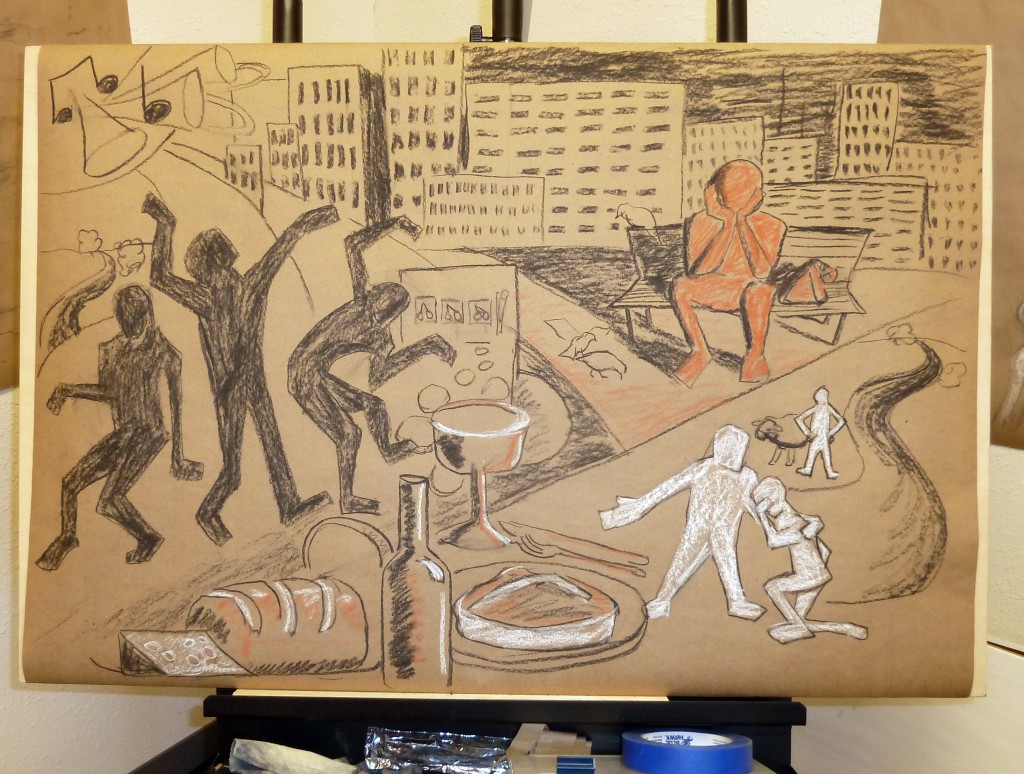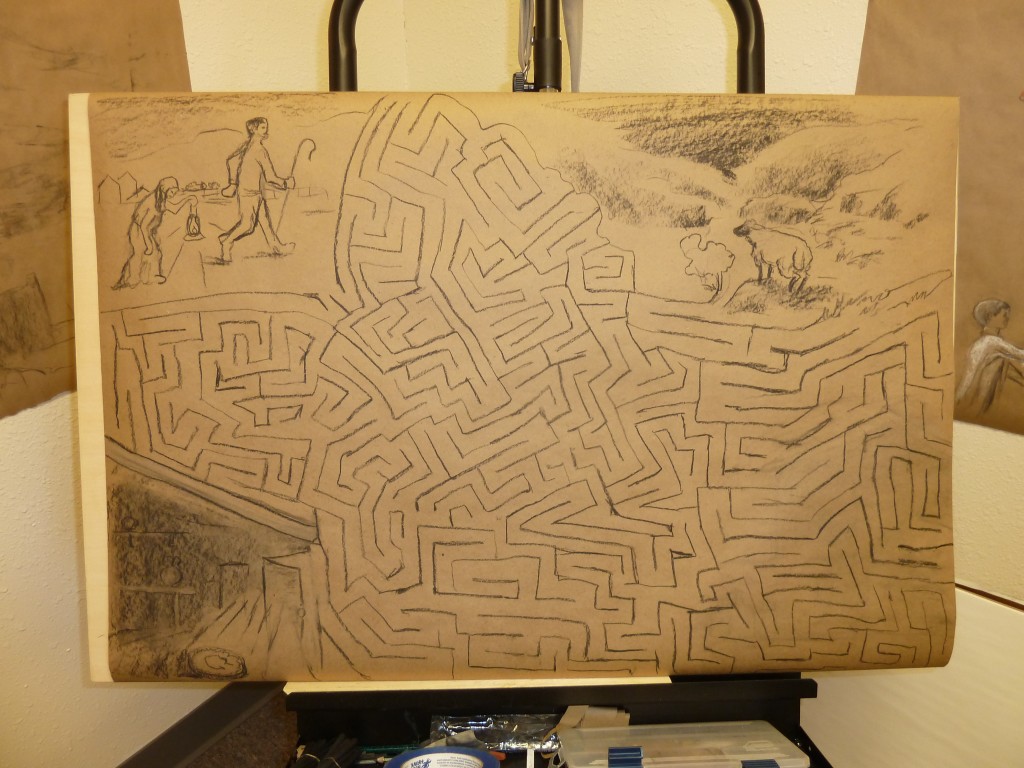The story typically known as the Prodigal Son deserves its reputation as one of the greatest of Jesus’ parables. The parable follows the younger of a man’s two sons as he rejects his father, comes to ruin, and then returns to his father’s warm welcome. It then shifts focus to the older son, who is angry with the welcome given his brother and refuses to join the celebration. The father gets the last word, pleading with the older son to join the party because his brother “was dead and is alive again; he was lost and is found.”
One of our regular class exercises is discussing possible names for the parables (the only named parables are in Matthew 13). This parable’s traditional name focuses on the younger son’s wastefulness (prodigal means wastefully extravagant) rather than his being lost (like the parables of the lost sheep and lost coin that precede it). I like the “The Lost Sons” since the parable is about two sons who are lost in different ways—just like the lost sinners Jesus welcomed and the Pharisees who complained about this. The parable could also be named after the father—“The Loving Father” or even “The Prodigal Father” (since he is wastefully extravagant in his love).
Kyle Snodgrass, who calls the parable “The Compassionate Father and His Two Lost Sons,” says: “The parable is a narrative demonstration of the grace with which God reaches out to embrace sinful people. Jesus did not need to introduce the idea that God accepts sinners, but his message of the kingdom emphasized that he was restoring Israel, that end-time forgiveness was being offered now, and that this was the critical time for repentance. The God that Jesus represents and proclaims is precisely the forgiving and merciful God reflected in the parable” (Snodgrass, Stories with Intent, p. 140).
Naomi’s drawing is a triptych showing the younger son squandering his wealth in wild living (note the slot machine), the younger son coming to his senses, and his father welcoming him home while the older brother looks on in disgust.
More art
I found far more art related to the Prodigal Son than any other parable and organized it by which aspect of the parable it depicts. Artists who painted multiple scenes from the parable include James Jacques Joseph Tissot, whose The Prodigal Son in Modern Life consists of Departure, In Foreign Climes, The Return, and The Fatted Calf, and Steve Prince, whose series (eyekons) consists of The Prodigal Appetite: Halloo, The Prodigal Journey: Exit Wounds, and The Prodigal Return: Your Past may be Stained,but your Future’s Untouched.
Sacred Art Meditations has a collection of Prodigal Son art. Images of Prodigal Son art from the Larry & Mary Gerbens Collection can be found online at eyekons and the Calvin College Center Art Gallery. I’ve linked to the images at eyekons (or to images at a Presbyterian church that hosted the art) because I can’t figure out how to link directly to art on the Calvin College page; however, bigger images can be found in Calvin’s slideshow.
Departure
- Carl Dixon. The Prodigal Son: The Departure.
- Bartolome Esteban Murillo. Departure of the Prodigal Son (1660).
-
Jan Weenix. The Departure of the Prodigal Son.
In a Distant Land
- Rembrandt van Rijn. The Prodigal Son in the Brothel (c. 1669).
- Metsu Gabriel. The Prodigal Son.
- Johann Wolfgang Baumgartner (1712-1761). The Prodigal Son Living with Harlots.
- Jan Sanders van Hemessen. The Prodigal Son (1536).
- Gerard van Honthorst. The Prodigal Son (1623).
- Palma Giovane. Amusements of the Prodigal Son (c. 1595).
Keeping Swine
- Andrei Rabodzeenko. Prodigal Son (2006).
- Korchagin. The Return of the Prodigal Son (lacquer box). (eyekons)
- Joel Tanis. The Return of the Prodigal Son (1994). (eyekons)
- Fritz Eichenberg. The Prodigal Son.
- Eric Jones. The Prodigal Son.
- Puvis de Chavannes. Prodigal Son (1872).
Coming to His Senses
- Stephanie Frostad. Prodigal Son: The Turning Point (2008).
- Rosa Salvator. Prodigal Son.
- Emile Salome (1833-1881). The Prodigal Son.
- Jeff Condon. Prodigal Son Diptych (2004). (eyekons)
Approaching Home
- Edward Riojas. The Prodigal Son (2004). (eyekons)
- Robert Barnum. The Return of the Prodigal Son (1998). (eyekons)
- Robert Hart Benton. Prodigal Son (c. 1939). (eyekons)
The Loving Father
- Karl Kwekel. Return of the Prodigal Son.
- Rembrandt van Rijn. The Return of the Prodigal Son (c. 1669).
- Jonathan Quist. Rembrandt’s Prodigal Son Revisited. (eyekons)
- Pompeo Batoni. The Return of the Prodigal Son (1773).
- Bartolomé Esteban Murillo. The Return of the Prodigal Son (c. 1674).
- Edward John Poynter (1836-1919). The Return of the Prodigal Son.
- Guercino. Return of the Prodigal Son (1619).
- Oleg Korolev. Prodigal Son.
- Charalambos Epaminonda. The Prodigal Son.
- Letterio Calapai. Hongry Catch the Foolish Boy (1946).
- Jan Weenix. The Return of the Prodigal Son (1669).
- James Jacques Joseph Tissot. The Return of the Prodigal Son (1862)
- John McDonald. Shelter from the Storm. (eyekons)
- Carl Dixon. Prodigal Son: Return. (Sacred Art Meditations)
- Pietro Faccini. The Return of the Prodigal Son (c. 1593).
- Athanasios Clark. The Byzantine Orthodox Icon of the Prodigal Son (2004). (eyekons)
- Edgar Boeve. The Prodigal Son: Forgiveness (2004). (eyekons)
- Soichi Watanabe. The Prodigal Son Returns.
- Alan and Aaron Hicks. The Prodigal Son.
- Jesus MAFA. The Prodigal Son. (eyekons)
- Christopher Koelle. The Prodigal Son (2005).
- Julie Quinn. Embrace. (eyekons)
The Fatted Calf
- Jacopo Bassano. The Return of the Prodigal Son (1510-1592).
- Stephanie Frostad. The Return of the Prodigal Son.
The Other Brother
- John Kohan. Detail from The Parables of Jesus. (Sacred Art Meditations)
- Guercino. Return of the Prodigal Son (1655).
- Ward Smith. Return of the Prodigal Son.
- Elmer Yazzie. The Prodigal Sons and the Father (2004). (Calvin College)
- He Qi. The Prodigal Son.
Multiple Scenes
- Max Slevogt. The Prodigal Son. (1899)
- Frans II Francken. The Parable of the Prodigal Son (1633).
- John August Swanson. Story of The Prodigal Son (2004). (eyekons)
- John August Swanson. The Prodigal Son (1984). (eyekons)
- James B. Janknegt. Two Sons (2002).
Music
Our class sang the same three songs for our Lost Sheep/Lost Coin class and our Lost Son class. Two—“Shepherd, Do You Tramp the Hills” (SNT #39) and “It Was God Who Ran to Greet Him” (AJS #37)—refer to all three parables with four stanzas, one for each parable and the fourth to sum things up.
The other is “Far From Home We Run, Rebellious” (AJS #39/SNT #40/LUYH #122)—one of the few parables songs in Lift Up Your Hearts—which is about the Lost Son. The son puts the singers in the position the younger son. Here is the first stanza:
Far from home we run, rebellious,
seeking cities bright with dreams.
casting loose from love that claims us,
craving life that glitters, gleams.
The song covers the parable in five stanzas; the sixth replaces the celebratory feast with communion: “Bread and wine for celebration on the table now are spread…”
There are three other songs in our hymnals based on the three “lost” parables: “A Shepherd with a Hundred Sheep” (AJS #35), “And Jesus Said” (AJS #36), and “Shepherd, Shepherd” (AJS #38). The other Lost Son song is “How Far Away Is Heaven” (AJS #40).
This is the fifth post in a series about the Parables of Jesus Sunday school class I co-taught at Trinity CRC in Ames. In each post, I make a few observations about the parable, share Naomi Friend’s original artwork she drew during our class, post links to other art about the parable, and share our favorite songs about the parable. Previous posts covered the Parable of the Sower, The Parables of the Mustard Seed & the Leaven, The Parables of the Hidden Treasure and the Pearl of Great Price, and The Lost Sheep and the Lost Coin.



